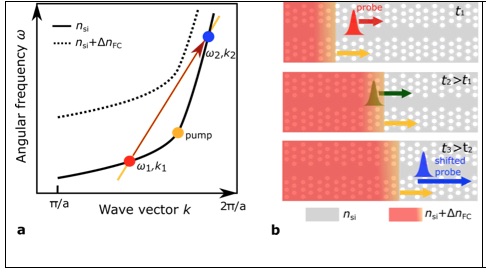One light pulse escapes from the other while changing its color

Figure 1: Left (a): Schematic representation of the indirect photonic transition using a band diagram. Solid line: dispersion function of the un-switched photonic crystal waveguide ahead of the moving front. Dashed line: dispersion function of the switched photonic crystal waveguide behind the moving front. Right (b): Schematics of the photonic crystal waveguide (silicon: grey. holes: white). The probing signal with lower frequency (red) stays in the un-switched waveguide, changes its color and accelerates in forward direction (blue). The approaching pump pulse forms a front and the free charge carriers are staying behind the front as a trail (orange). All signals have wavelengths in the vicinity of 1550 nm in the near infrared. Photo: TUHH
When the pump pulse reaches the signal pulse, upon interaction, the signal pulse accel-erates, changes its frequency, respectively its color, and finally escapes from the pump pulse in forward direction.
This novel effect is related to the “event horizon” concept which theoretical physicists use to describe the vicini-ty of black holes where this limit marks the “point of no return” of photons.
No light particle inside can cross this event horizon to reach the outside world and all these photons are inevitably consumed by the black hole. Such walls for light and changes in the light velocity and color are non-existent in our everyday lives and can be ob-served under very special conditions, only.
How does this work?
The pump pulse generates free electrons in the silicon which creates a fast forward moving front. Since the charge carriers live long compared to the pump pulse duration they are staying behind the propagating front as a trail.
The conditions have been chosen by careful design of the waveguide such that the signal pulse cannot penetrate into the space behind the front and escapes in forward direction, instead. Since both the frequency and the wave number of the signal are changed, which is quite unusual, the effect is called an “indirect” photonic transition, which is now theoretically described, numerically modelled and experimentally verified.
Under the leadership of the Hamburg based researchers scientific insights of fundamental importance have been gained which, in addition, are crucial for applications in ultra-fast optical telecommunications.
As a result of the particular waveguide design, very strong effects can be realized with comparatively small pump power which makes this novel technique particularly attractive for “on-chip” frequency conversion and for all-optical switch-ing.
The work was published on 13.04.2018 in Nature Communications, one of the highest prestigious international scientific journals.
Publication:
Online: https://www.nature.com/articles/s41467-018-03862-0
Reflection from a free carrier front via an intraband indirect photonic transition, Mahmoud A. Gaafar, Dirk Jalas, Liam O’Faolain, Juntao Li, Thomas F. Krauss, Alexander Yu. Petrov, and Manfred Eich,
Nature Communications 9, 1447 (2018), doi 10.1038/s41467-018-03862-0
Further information:
Prof. Dr. Manfred Eich
Technische Universität Hamburg-Harburg (TUHH), Institut für Optische und Elektronische Materialien,
Eißendorfer Straße 38, D-21073 Hamburg
and
Institut für Werkstoffforschung, Helmholtz-Zentrum Geesthacht, Max-Planck-Strasse 1, Geesthacht, D-21502, Germany,
Tel +49 40 42878 3147
E-Mail: m.eich@tuhh.de,
Website: www.tuhh.de/alt/oem/home.html
Media Contact
More Information:
http://www.tuhh.deAll latest news from the category: Power and Electrical Engineering
This topic covers issues related to energy generation, conversion, transportation and consumption and how the industry is addressing the challenge of energy efficiency in general.
innovations-report provides in-depth and informative reports and articles on subjects ranging from wind energy, fuel cell technology, solar energy, geothermal energy, petroleum, gas, nuclear engineering, alternative energy and energy efficiency to fusion, hydrogen and superconductor technologies.
Newest articles

Properties of new materials for microchips
… can now be measured well. Reseachers of Delft University of Technology demonstrated measuring performance properties of ultrathin silicon membranes. Making ever smaller and more powerful chips requires new ultrathin…

Floating solar’s potential
… to support sustainable development by addressing climate, water, and energy goals holistically. A new study published this week in Nature Energy raises the potential for floating solar photovoltaics (FPV)…

Skyrmions move at record speeds
… a step towards the computing of the future. An international research team led by scientists from the CNRS1 has discovered that the magnetic nanobubbles2 known as skyrmions can be…





















